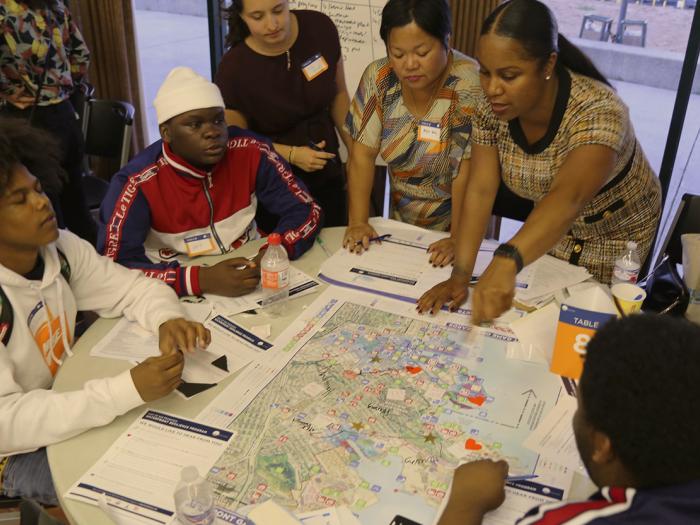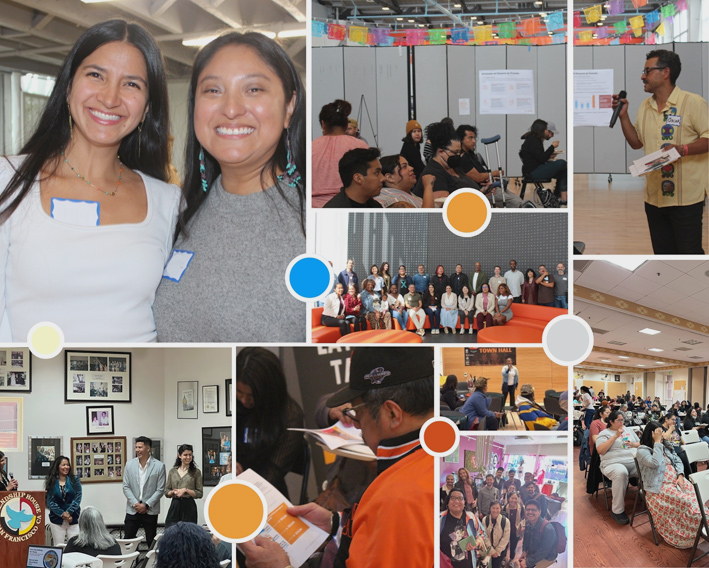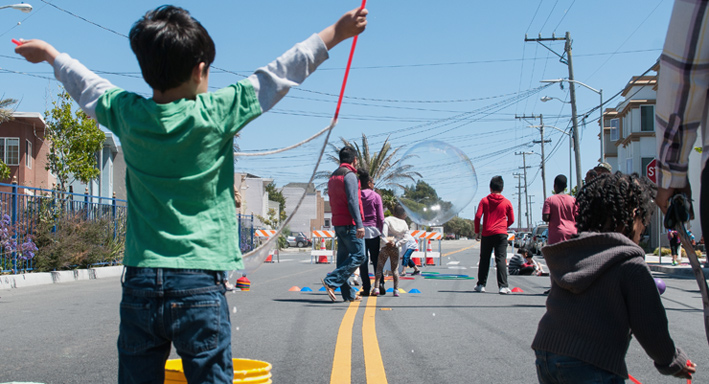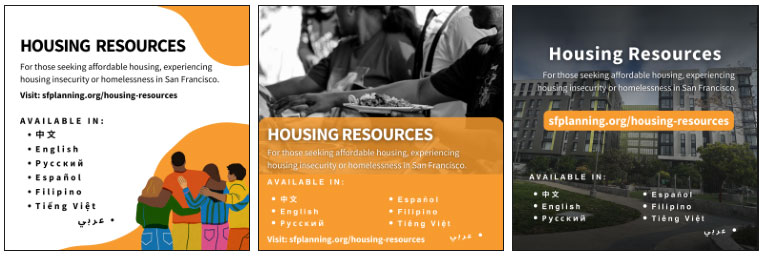
Activating Community Priorities
Part of the Housing for All initiative
Collaborate with Equity Communities and Cultural Districts to act on housing needs.

A collage of Workshops and Housing Policy Discussions
photo: SF Planning
Activating Community Priorities is a component of the San Francisco Housing Element Implementation effort, now known as Mayor Breed’s Housing For All initiative. The Housing Element includes over 350 actions identified through feedback from diverse communities and stakeholders to address a range of housing issues. To help focus the City’s Housing Element implementation, SF Planning initiated the Activating Community Priorities effort to return to Equity Communities to identify their top housing priorities.
The outreach and community development for Activating Community Priorities launched in Spring 2023 through community workshops engaging hundreds of people throughout San Francisco's Equity Communities. SF Planning partnered with Equity Communities’ residents and organizations, Cultural Districts, and City departments to achieve the following goals:
- Broaden community awareness of the Housing Element and its community-identified housing priorities.
- Support community planning by engaging Equity Community voices and the organizations that serve them.
- Strengthen long-term community engagement in the implementation of housing policies, programs, and projects.
SF Planning has made a concerted effort to carry forward community voices throughout the Housing Element process:
- 5,750 participants engaged across 27 community workshops
- 2,748 survey respondents provided input and feedback
- View the Public Participation Report for all engagement conducted for the 2022 Housing Element
The Activating Community Priorities process has produced additional feedback and clarified housing priorities:
- Specific housing priority lists for 7 Equity Communities
- To further raise Equity Community voices, 12 common priorities were identified
Throughout this process SF Planning created educational and resource materials to be used broadly:
- A Housing Resource Guide that has been translated into 6 languages
- Affordable Housing 101 fact sheets for easy and accessible reference and education
- Housing Element Field Guides to support community members facilitate their own conversations about housing in San Francisco
Learn more about San Francisco’s Community Housing Priorities on the next tab.
SF Planning and community leaders developed multi-pronged approaches, referenced existing documents, and co-facilitated conversations that were tailored to each community. This process supported community-led planning by connecting Housing Element actions with urgent needs.
Click below to view each list of housing priorities.
American Indian
In partnership with SF Planning, Friendship House Association of the American Indians (FHAAI) and the American Indian Cultural District (AICD) cohosted a housing workshop for the American Indian community. Over 100 community members participated in the June 15th workshop. Attendees received a summary of housing concerns articulated by their community during the Housing Element outreach.
Feedback on the American Indian housing priorities informs the department’s implementation of the Housing Element. Additionally, feedback will support Friendship House’s Village SF initiatives and the development of AICD’s housing strategies for the CHHESS report.
Community priorities
- Special status: Provide special status and prioritize American Indian residents for housing opportunities to redress the historic dispossession of resources.
- Indian Relocation Act: Realize housing promised through Indian Relocation Act.
- Deeper Affordability: Produce housing units with deeper affordability to address the actual needs of the American Indian community.
- Diverse Housing to meet Diverse Needs: Build housing for multi-generational households, families with children, Two-spirit/LGBTQ community, people with disabilities, people in recovery and elders.
- Housing Choice: Expanding housing choices by building affordable housing in neighborhoods that have excluded low-income residents.
- Right-to-return and Anti-displacement: Increase relocation assistance for tenants experiencing temporary or permanent evictions and bring back displaced Native residents.
- Homeownership: Increase investment in down payment assistance loan programs for American Indian community.
- Affordable Housing Developers: Partner and support non-profit housing developers managed by the American Indian community.
- Housing Counseling/Workshops: Provide affordable rental/homeownership counseling and workshops for American Indian community members by partnering with Native-serving organizations.
- Improve Access to Affordable Housing and Remove Barriers: Simplify and improve the application and lottery system process to increase percentage of American Indian residents allotted housing. Reduce barriers such as credit scores to access affordable housing.
To learn more about these community priorities, contact: sydney.cespedes@sfgov.org
Black / African American
SF Planning partnered with the San Francisco African American Reparations Advisory Committee and Young Community Developers to gather Black and African American community needs related to housing and homeownership.
SF Planning Staff hosted focus groups and working sessions to review, revise, and narrow down a long list of housing and homeownership priorities. The list recommendations were sourced from public plans and reports:
- Dream Keepers Initiative Reallocation Report, San Francisco Human Rights Commission
- San Francisco Reparations Plan 2023, San Francisco African American Reparations Advisory Committee
- 2022 Housing Element, SF Planning Department
In addition to the outreach that was included in the 2022 Housing Element update, the San Francisco Reparations Plan and Dream Keepers Report were developed with San Francisco’s Black and African American community participation. All efforts are meant to guide reinvestment as well as future investments.
The Community priorities list was co-developed and verified with residents and organizations with connections to the historically Black neighborhoods as well as parts of the city.
Community priorities
- Building Population-Specific Income-Based Housing: Build, preserve, and purchase affordable housing specifically for Black communities and Black neighborhoods.
- Supporting Black-Led Housing Cooperatives: Promote the development of new and continued growth of existing, Black-led housing cooperatives by taking actions to expand available opportunities.
- Establish (and provide at least five years of initial funding for) a community land trust governed by Black residents to procure and develop properties in target neighborhoods.
- Prevent Discrimination Against Section 8 Voucher Holders: Stop discriminatory practices amongst landlords and property managers who do not want to rent to Section 8 voucher holders, who are disproportionately Black women with children.
- Increasing Funding for Black-Led Organizations Addressing Homelessness: Increase funding and support to Black-led organizations providing direct services to unhoused Black and people of color. Create capacity-building opportunities for Black-led and staffed organizations (with lived experience with homelessness) to better serve Black unhoused communities.
- Supporting Existing Black Homeowners: The City and County of San Francisco and MOHCD should offer grants to low- and moderate-income Black homeowners for home maintenance, rehabilitation, and costs for construction of Accessory Dwelling Units (ADUs). Grants should be inclusive of programs to remove mold, lead, and other health hazards through programs such as Fix Lead SF and CalHome.
- Removing Barriers Limiting Wealth-Building Potential in the BMR Program: MOHCD should address and remove barriers built into the BMR program that limit wealth-building potential.
- Creating an Ownership Program for Public Housing Residents: Convert public housing units into condominiums with a $1 buy-in for qualifying residents so the residents can own not only their unit but the common areas as well.
- Improving the Dream Keeper Down Payment Assistance Loan Program (DK-DALP): Guarantee continued funding for the Dream Keeper Down Payment Assistance Loan Program (DK-DALP) and convert the program from a loan to a forgivable grant over the course of 10 years. Make available to all eligible Reparations recipients, regardless of income.
- Improving Outcomes in the Certificate of Preference Program (COP): Eliminate the housing lottery process for Black COP holders, granting automatic qualification and first right of refusal to any rental or homeownership opportunities, with all financial eligibility needs met by the city.
- Removing Existing Barriers in the BMR Program: Remove barriers to qualification for subsidized and Below Market Rate (BMR) rental units. MOHCD should offer first choice for rental units to those who qualify for Reparations, and the City should cover any cost differentials that may serve as a barrier to qualification.
Japantown
The Japantown community has engaged in community planning for over two decades. In partnership with SF Planning, the Japantown Task Force crafted a Better Neighborhoods Plan. Japantown became San Francisco’s first designated Cultural District in 2013 and has been a key partner for initiatives like the 2013 Japantown Cultural Heritage and Economic Sustainability Strategy and the 2023 Cultural History, Housing, Economic Sustainability Strategy or CHHESS report.
These efforts reflect the evolution of years of community planning and engagement with the recent CHHESS process with involving over 500 community merchants, business owners, and residents participating in 8 focus groups, 3 town hall meetings, and one-on-one interviews to create this community vision plan.
Community priorities
- Work with property owners, developers, and the City to develop opportunities for affordable housing that is culturally affirming in design.
- Explore opportunities to establish a community development corporation/community land trust/community investment fund or a similar mechanism and work with the City to acquire property for community control.
- Work with the City to officially acknowledge the impacts of Redevelopment in Japantown, and champion equitable development and housing choice to reverse and repair its impacts on the Japanese/Japanese American community.
- Explore new strategies to work with existing residential tenants and descendants of those displaced by redevelopment, property owners and the City to protect residential tenants from displacement and to place Certificate of Preference holders, artists, culture bearers, families, younger generations, and employees of community-based organization, in existing housing.
To learn more about these community priorities, contact: maria.dealva@sfgov.org
Mission / Latino
The Latino community's housing priorities reflect a multi-year community engagement process that includes a grassroots community-led effort and the Mission Action Plan 2020 (MAP). MAP2020 was a community-initiated planning process that began in 2015 as a collaboration between Latino-serving community organizations and City Departments to slow the trend of displacement taking place in the Mission District.
Recent Housing Element outreach built off existing MAP2020 collaborations and further engaged with Latino and Spanish speaking community members to update current housing needs and concerns. Many of MAP2020’s original solutions are reflected in the current Latino housing priorities.
During August and September of 2023, SF Planning partnered with the Latino Task Force and SF Latino Parity and Equity Coalition to ensure their expertise and leadership was integrated into policy and planning for Latino housing priorities. Planning staff were a part of enlightening conversations with elders, youth, tenants, women, low-income workers, organizers, homeless and others impacted by high rents, evictions, and a lack of affordable housing options.
Community priorities
- Produce Affordable Housing: Acquire land to build 100% affordable housing for a range of income and household needs, such very low-income, multi-generational households, families with children, seniors, people with disabilities.
- Preserve Affordable Units: Increase City funding for the purchase and rehabilitation of buildings where low-income tenants might otherwise be evicted.
- Improve Single Room Occupancy Hotels: Increase community programs that provide supportive services for SRO residents, incorporating culturally responsive services for immigrant new arrivals.
- Eliminate Homelessness: Provide additional housing and services for immigrants, women with children and transitional aged youth.
- Expand wealth building: Increase investment in down payment assistance loan programs for homeownership, and community-based commercial ownership.
- Strengthen Housing Support: Increase support for organizations and programs that successfully navigate and access rental housing such as DAHLIA, lease-up support, locating affordable private-market housing, tenant counseling, legal representation, and know your rights resources.
- Increase Access to Affordable Housing: Better serve, reach, and house the Latino community by removing barriers to the affordable housing application and qualification process; this includes language access and standard financial documentation such as credit histories, bank accounts, employment verification, or current leases.
- Community-Led Planning: Strengthen Latino community participation in land use, housing and commercial decisions, legislation and investments to ensure the community thrives.
- Strengthen Latino Commercial Corridors: Increase commercial spaces for economic, culture and arts, and other community serving activities in new developments and existing buildings.
- Cultural and Traditional Arts Space: Provide resources and support for an initiative that identifies and acquires a space for an Indigenous Mexica cultural facility.
To learn more about these community priorities, contact: oscar.grande@sfgov.org
SOMA
The SOMA Pilipinas Cultural History, Housing, and Economic Sustainability Strategies (CHHESS) report was adopted in September 2022. This plan proposed a set of community-informed strategies to support the thriving Filipino community in SOMA. SOMA Pilipinas developed these strategies over a year-long outreach, feedback, and input process. They held 12 focus groups, conducted over 20 interviews, collected over 40 surveys specifically aimed at seniors and unhoused Filipino residents, and held a final community presentation of the strategies.
In August 2023, SF Planning and SOMA Pilipinas staff selected priorities to highlight the specific housing needs of the Filipino community.
Community priorities
- Protect and stabilize buildings containing a high proportion of Filipino tenants.
- Build capacity and Filipino cultural competence to support residential acquisition and rehabilitation in SOMA.
- Improve housing affordability for seniors, families, and other low-income Filipino households.
- Increase language & culturally competent housing readiness to access affordable, BMR, and supportive housing.
- Ensure that the displacement of the Filipino community is part of the discourse in Planning’s racial equity plan initiative.
- Establish a working group to examine, the youth and family special use district.
- Increase community-based access, use, and stewardship of land, buildings, and space.
- Ensure that housing and neighborhood services serve Filipino seniors, families, and children.
To learn more about these community priorities, contact: lauren.hiller@sfgov.org
Sunset
The Sunset’s housing priorities and strategies were identified during the community-led campaign Sunset Forward, a project that engaged over 2,500 community members through virtual and in-person outreach from April 2020 to May 2022. These priorities and strategies were later vetted with key community leaders during the 2022 Housing Element update, and again in August 2023.
During this process, SF Planning met with community leaders representing Wah Mei School, the District 4 Youth and Families Network, Self-Help for the Elderly, and the Sunset Chinese Cultural District.
Community priorities
- New Affordable Housing: Produce new 100% Affordable Housing for seniors, families, and transitional aged youth (TAY) with community-serving ground floor space and support services for low-income residents. Ensure middle-income households can qualify for affordable housing units.
- Land Acquisition and Land Banking: Secure land through land purchase, land dedication, and use of public land and faith-based sites for affordable housing.
- Create a funded land banking program to purchase sites that could accommodate at least 50 units on each site, such as faith-based or underutilized sites.
- Expand the Community Opportunity to Purchase Act (COPA) and Small Sites Programs: Support nonprofit developers and conduct proactive tenant outreach for small sites acquisitions to make units permanently affordable.
- Westside Affordable Housing Developer(s): Build capacity for Westside nonprofit developer(s) to build new affordable housing and acquire small sites to make them permanently affordable. Support the creation of a Westside Community Development Corporation (CDC) or community coalition-building for affordable housing development.
- Accessory Dwelling Units (ADU): Support low- and middle-income homeowners navigate the ADU process through technical and financial assistance, incentivize homeowners to rent their units, and provide educational trainings on property management and landlord and tenants’ rights.
- Community Housing Education and Capacity Building: Create educational materials and host informational workshops to build community capacity and increase community knowledge and involvement in affordable housing projects. Increase community awareness of tenant and property owner rights and responsibilities and appropriate practices to ensure tenants have maximum stability. Expand access to existing affordable housing programs.
- Expand Housing Choice: Analyze zoning and make planning code changes, including raising height limits and removing density controls, to allow for mid- to large multi-family buildings along commercial and transit corridors in District 4
- Senior Housing and Support Services: Build new senior housing of all types (e.g., independent living, skilled nursing, etc.) with support services and create a program that allows senior homeowners to age-in-place.
To learn more about these community priorities, contact: carla.demesa@sfgov.org
Tenderloin
In the last 3 years, multiple initiatives have focused on identifying community priorities in the Tenderloin. Efforts include the 2021 Tenderloin Community Planning Survey, the Department of Homelessness and Supportive Housing’s Home by the Bay plan and the 2022 Housing Element update.
City staff from many city government agencies gathered critical community priorities based on the responses from focus groups and the 1,326 survey respondents in the Tenderloin Community Planning Survey. In August and September of 2023, staff had two additional discussions with CBOs and service providers to validate priorities and refined them to reflect more specific needs.
Community priorities
- Improve and maintain existing deeply affordable housing assets: Develop a rehab strategy for SROs and permanent supportive housing units that are in poor physical conditions to ensure a dignified standard of living in existing assets.
- Protect Vulnerable Residents at most risk of homelessness: Extend deeper subsidies (operating subsidies, rental assistance, etc.) for tenants and buildings to stabilize residents and prevent evictions and homelessness.
- Preserve affordability and existing assets through acquisition: Solidify an acquisition strategy in the Tenderloin in order to preserve existing assets (e.g., Master Leased SROs) and leverage available low-cost privately owned buildings offered for sale through COPA.
- Expand on-site case management services, especially behavioral health and substance use disorder: Expand access to on-site or off-site Behavioral health and substance use treatment through increasing residential treatment facilities, increase in on-site staffing, or treatment facilities.
- Improve access to affordable housing suitable for families with children and Transitional Aged Youth (TAY): Develop a housing strategy, identifying housing targets, specifically for families with children and youth experiencing homelessness. Create family friendly housing options and build amenities and programming in housing for TAY. Provide culturally sensitive and linguistically appropriate housing counseling and materials for Limited English Speaking residents.
- Reduce vacancies in existing permanent supportive housing buildings: Identify sources of funding for rehab and continue to find solutions to fill vacant units and accelerate housing placement in supportive housing.
Visit the Tenderloin Community Action Plan webpage to learn more.

Playstreets event photo: SF Planning
SF Planning and community leaders co-facilitated dialogues in San Francisco’s Equity communities to identify housing policy priorities. The aim is to meet the urgent housing needs of American Indian, Black, other communities of color and historically marginalized communities.
Under the guidance of the Equity Council, Planning staff integrated the seven Community Housing Priority lists into 12 Collective Housing Priorities.
They are informing San Francisco’s various housing committees, taskforces, working groups and elected officials in their efforts to achieve 86,000 units, half of which must be affordable, by 2031:
- Expand production of affordable housing for lower income people with diverse needs, including different household types, ages, abilities, and cultures, and ensure 100% affordable housing is built in both priority equity and well-resourced areas.
- Expand preservation of existing housing affordable at low and moderate incomes, such as multifamily rental, SROs, and co-ops, through maintenance, rehabilitation, and acquisition, ensuring that preservation programs, such as Small Sites, meet the needs of each equity community.
- Invest to establish and/or grow community capacity to own, produce, and preserve affordable housing in equity communities that currently lack nonprofit developer capacity.
- Expand rent assistance and operating subsidies to provide deeper affordability and stabilize buildings serving the lowest income renters and people most vulnerable to homelessness.
- Implement and expand low- and moderate-income homeownership programs, particularly for communities that have faced housing discrimination, including programs for homebuyers and to help homeowners maintain their homes, build wealth, add accessory units, and age in place.
- Strengthen culturally competent homelessness response by improving living conditions, speeding placement, increasing case management in supportive housing and expanding shelters and interim housing with services, especially substance abuse treatment.
- Maintain and increase tenant protection assistance and services that are culturally and linguistically responsive to diverse communities, including to address discrimination against Section 8 voucher holders.
- Build capacity for community-based organizations to provide linguistically and culturally responsive housing education, navigation, and other services to increase housing knowledge and access and prevent or exit homelessness.
- Address eligibility barriers and inequities in the affordable housing placement process to increase affordable housing access for communities with disproportionate needs and honor preferences.
- Implement or expand housing policies, programs, and preferences that redress racial discrimination and/or honor promises to harmed communities, responding to actions such as the Indian Relocation Act, redlining, redevelopment, and Japanese internment.
- Adopt zoning and processes that encourage more varied housing and living options for diverse needs in well-resourced areas, such as family-friendly multifamily housing, senior housing, housing for people with disabilities, and residential care facilities.
- Strengthen community decision-making on land use in equity communities to support housing, culture, arts, economic vitality, and community-serving uses.
SF Planning will continue to report back to communities and seek input on the priority actions listed above.
Housing Policy Information and Resources
This Community Toolbox is a free, online resource to empower communities to get involved in housing and work toward racial and social equity.
SF Planning created these tools to:
- Improve access to information
- Broaden awareness of affordable housing processes
- Support community planning
Use these to tools facilitate housing policy conversations, learn about San Francisco’ Resources, and amplify your community’s participation in local policymaking.
Understanding Housing Policy
Use these tools, resources, and factsheets to learn about San Francisco’s housing ecosystem and policies.
- Affordable Housing 101 Fact Sheet
- Helpful SF Planning Links and Acronyms
- Planning Glossary 2023
- Housing Element Community Field Guide
Housing Resources for Community
Connect to Housing Resources and Tenant Protection services:
- Coming Soon: How to Apply for Affordable Housing in SF
- Housing Resources & Tenant Protections
- Download the Social Media kit to promote the Housing Resources and Tenant Protections Guide (.zip file)

Our team is regularly updating content, so be sure to check in frequently. If you have any questions or would like to contribute to this toolbox, please reach out to: cpc.communityplanning@sfgov.org
| Phase | Details |
|---|---|
| Winter 2023 | California Department of Housing and Community Development (HCD) approves San Francisco’s Housing Element. |
| Spring 2023 | Mayor London Breed announces Housing for All Directive. |
| Summer 2023 | Community Housing Priorities |
| Fall 2023 / Winter 2024 | Activating Community Priorities process and the Collective Housing Priorities presented to the Affordable Housing Funding and Strategies Committee. |
| Spring 2024 | SF Planning to submit Housing Element updates to California Department of Housing and Community Development (HCD). |
| Spring 2025 | SF Planning to publish report of completed short term actions. |
Contact
For questions on the project, contact CPC.CommunityPlanning@sfgov.org, or:
Miriam Chion
Director Community Equity Division
miriam.chion@sfgov.org
Julia Sabory
Community Engagement Team Manager
Community Equity Division
julia.sabory@sfgov.org
